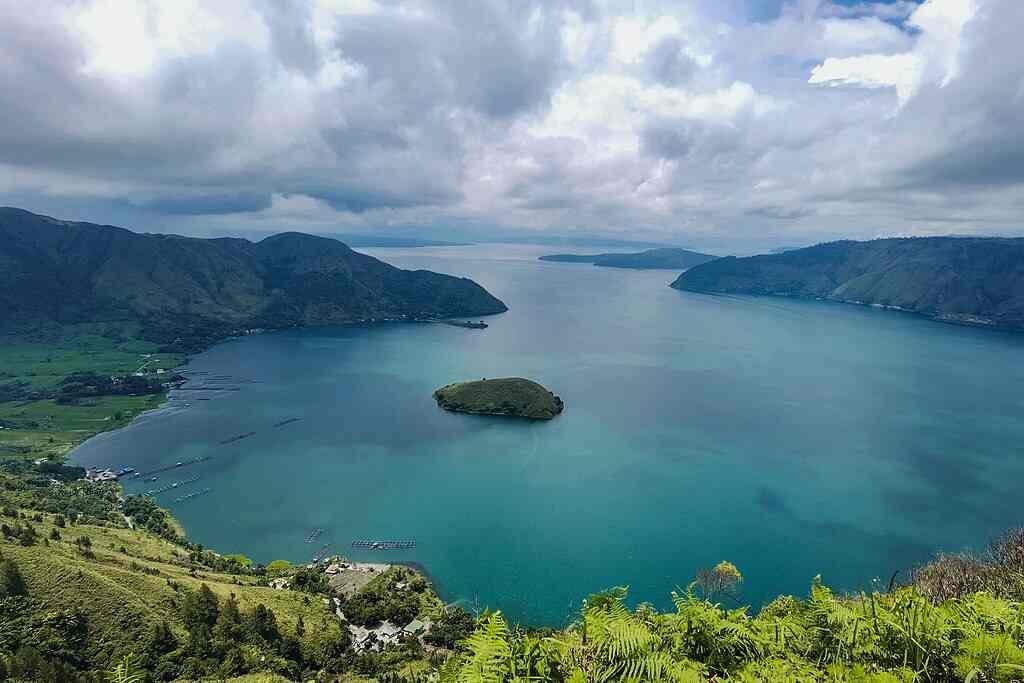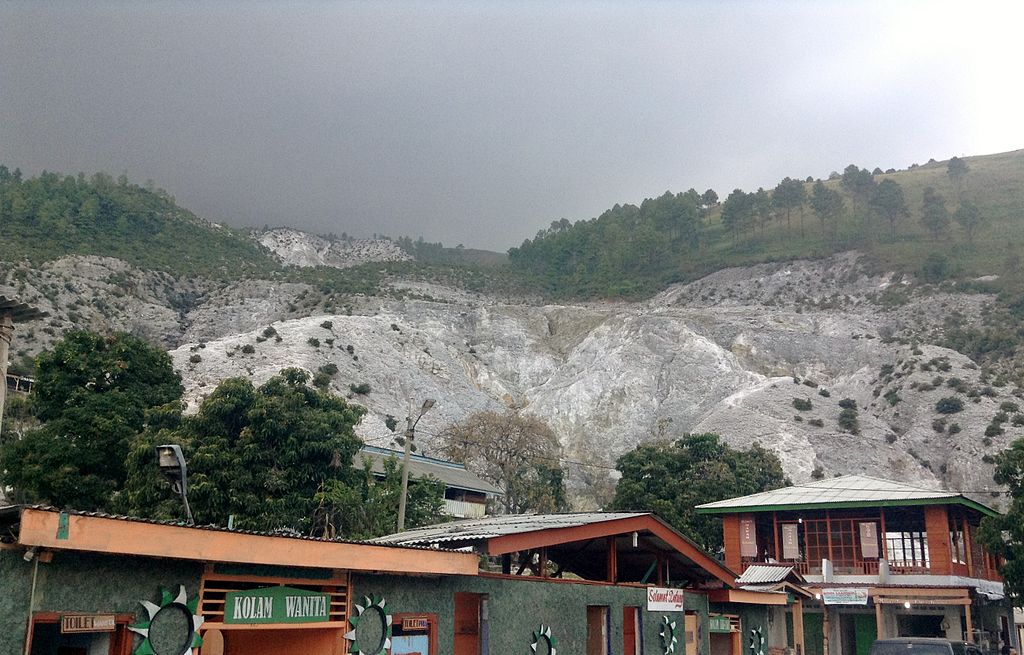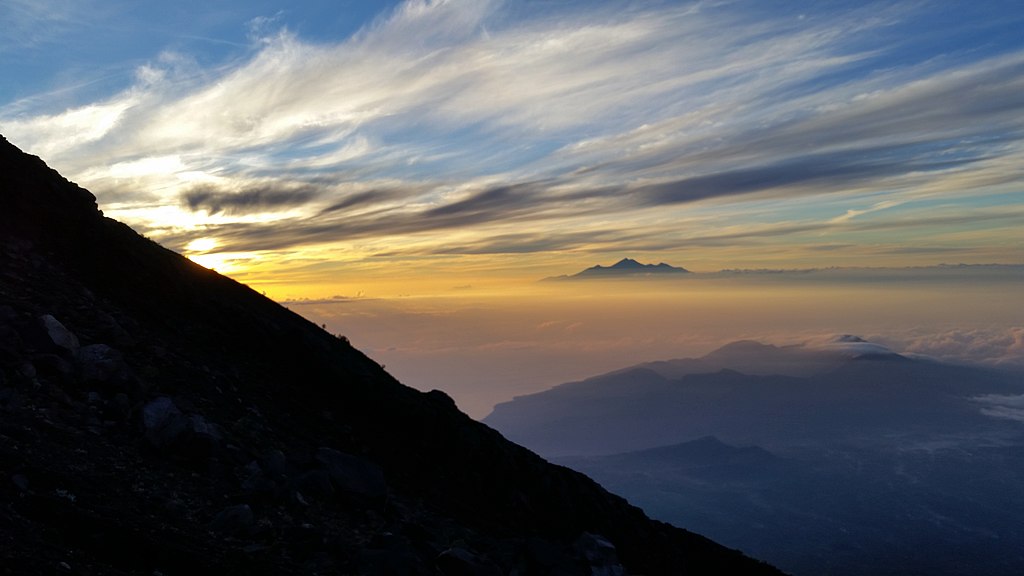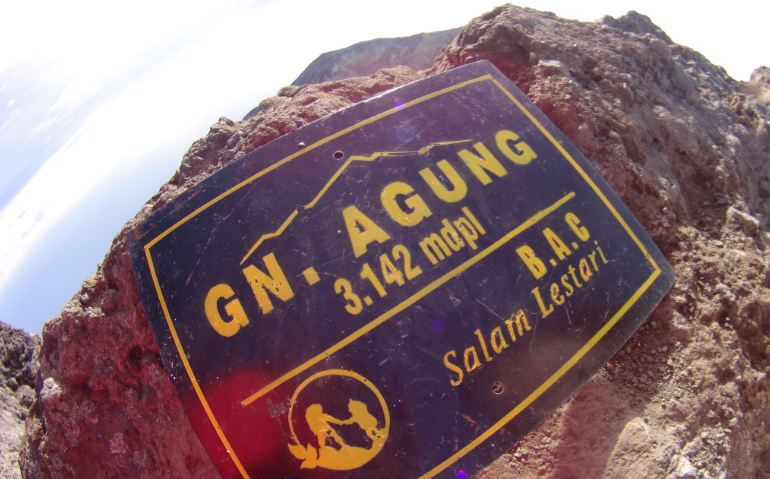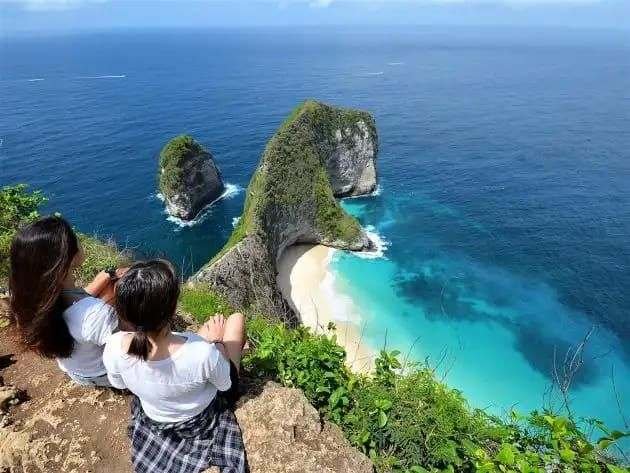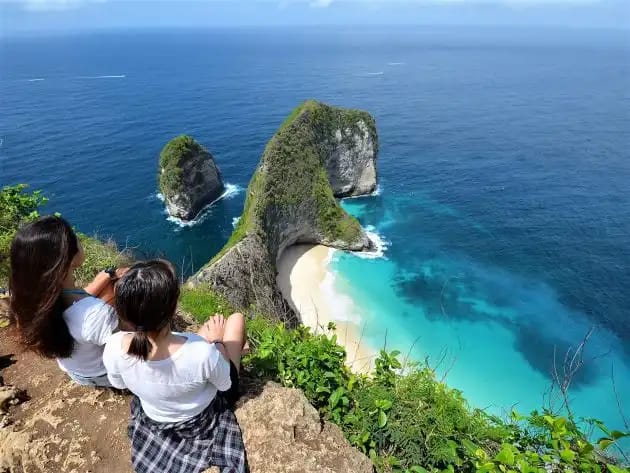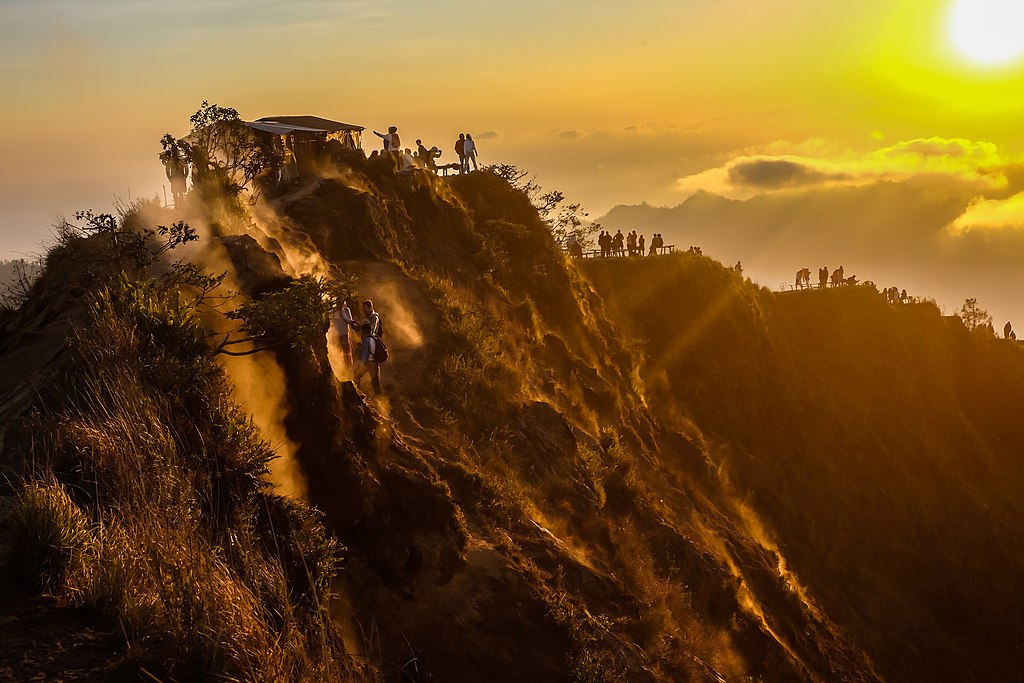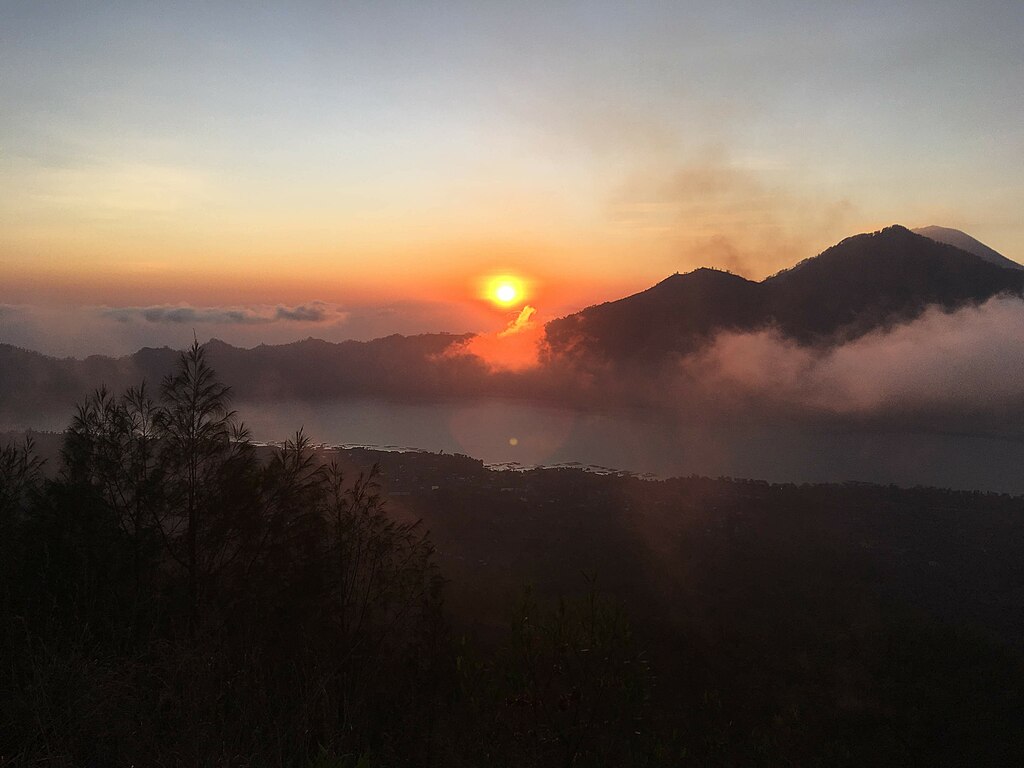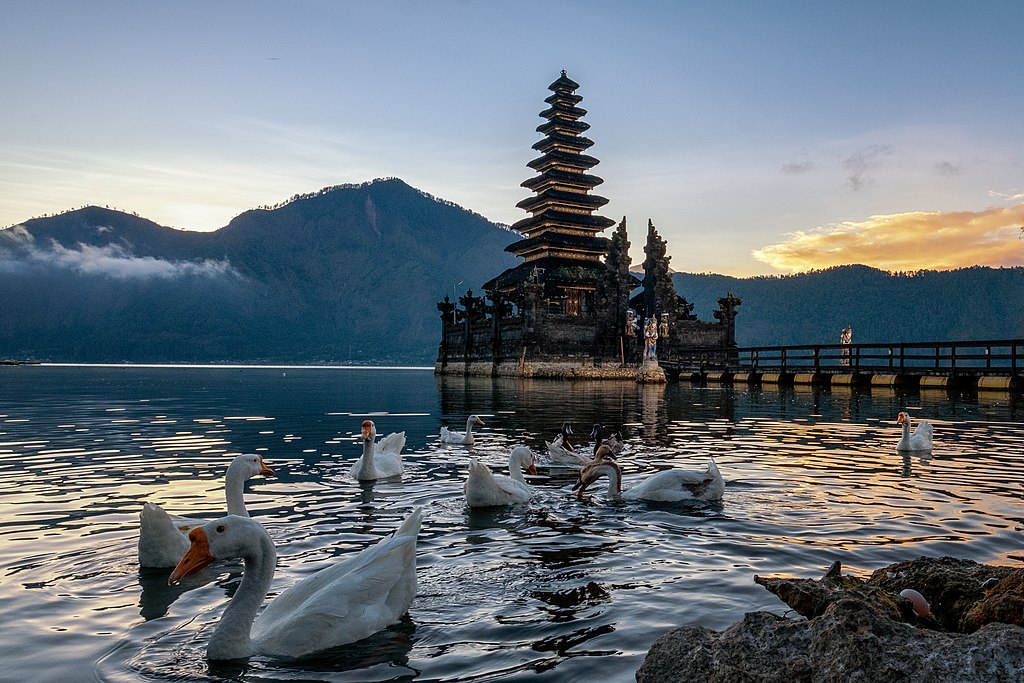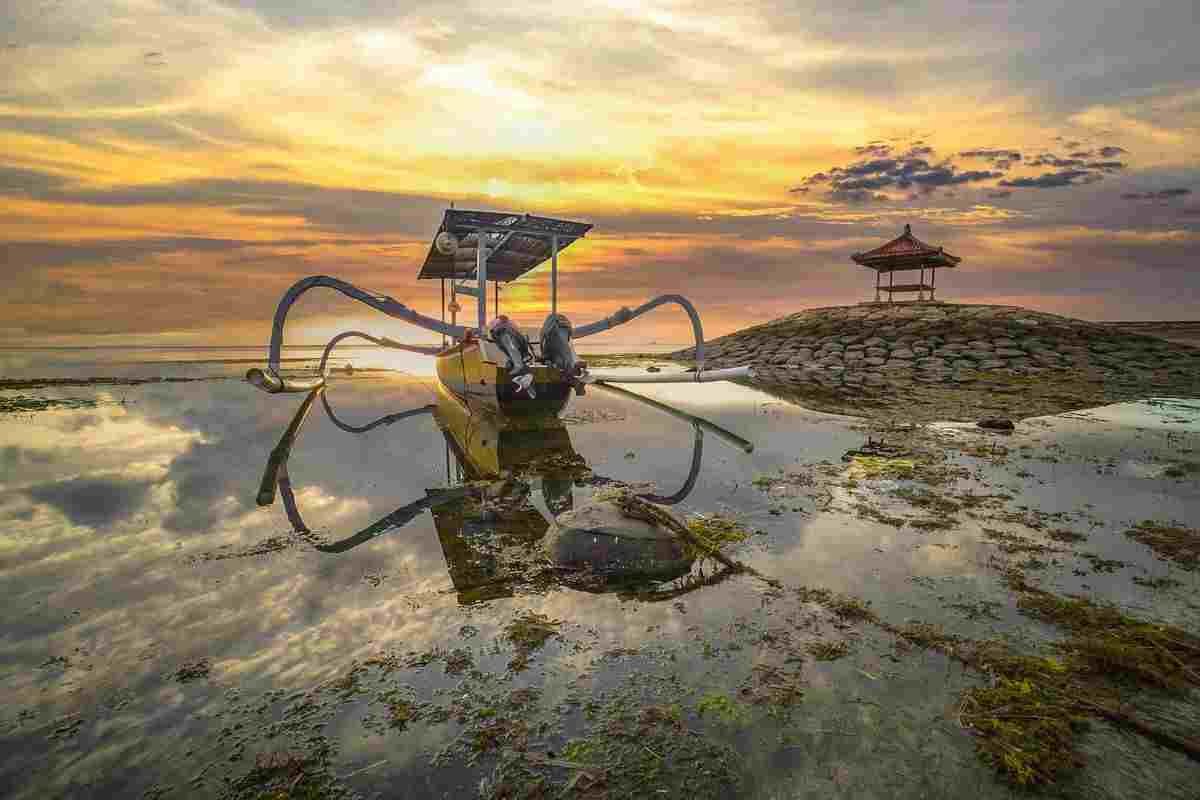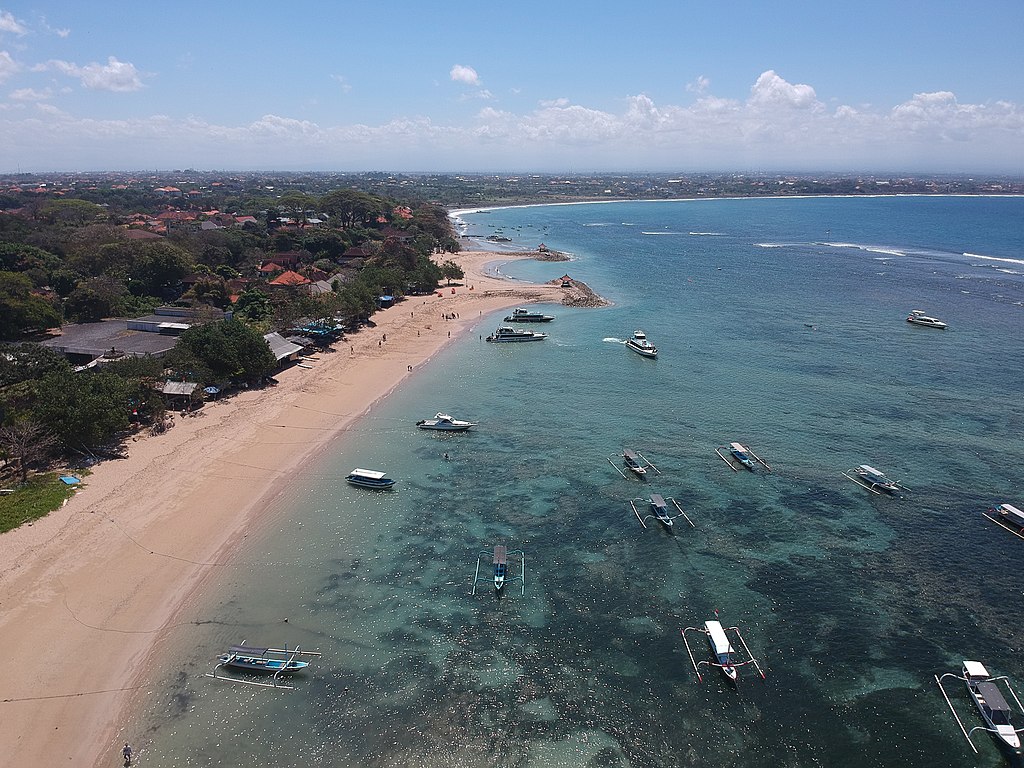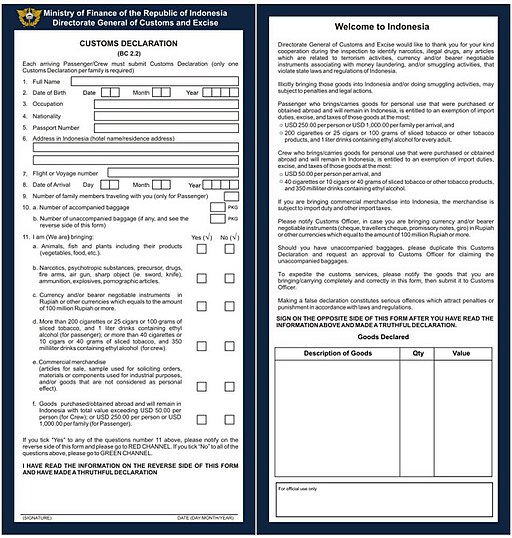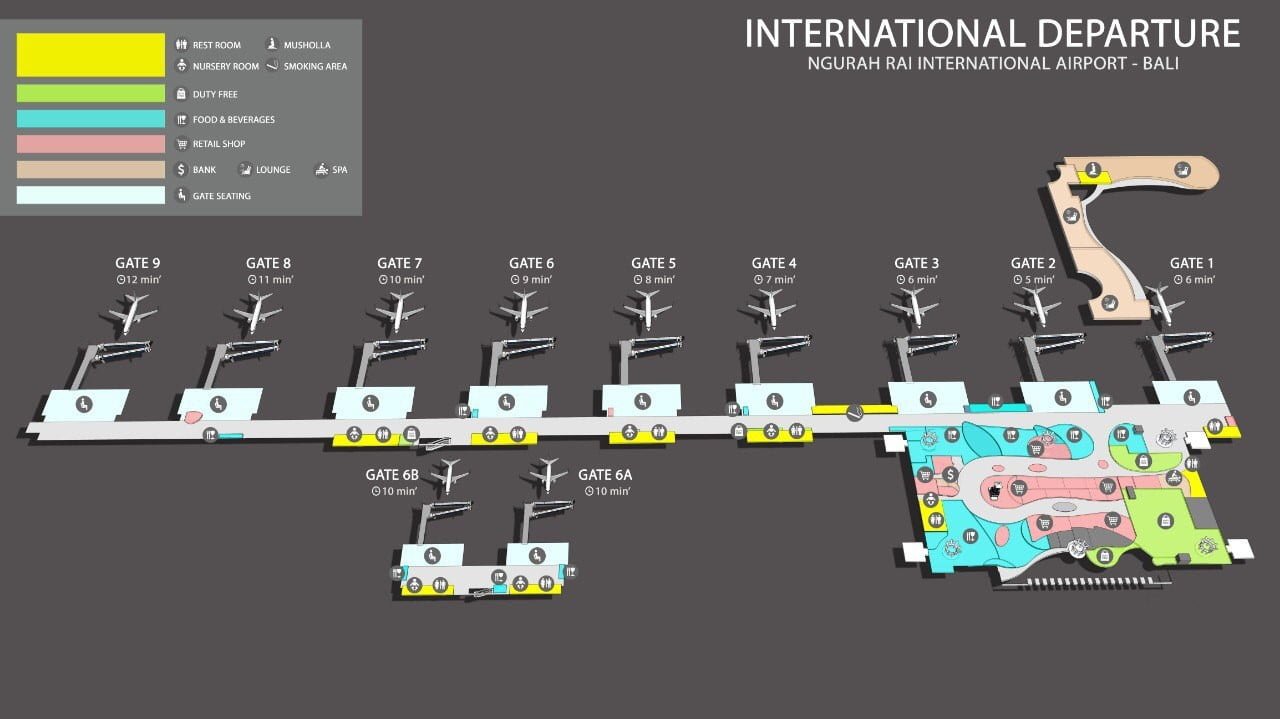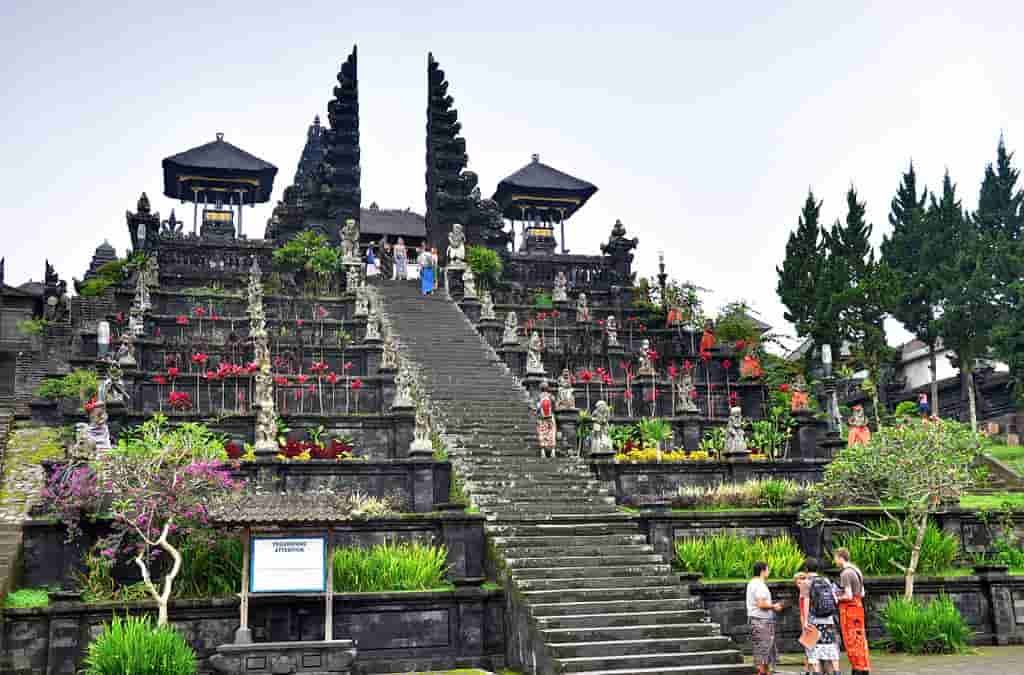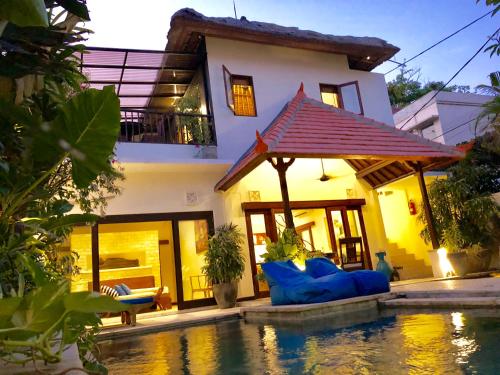Lake Toba off the beaten track
Lake Toba, what to see? what to do? How to go from Bali to Lake Toba? Lake Toba is a masterpiece of Mother Nature, as she does so well. She imagined everything like this: a dark volcano, a blue lake in it, with a fertile island on it. Isn’t that a masterpiece? It’s magnificent, relaxing, rejuvenating… In short, an essential stopover during a trip to Sumatra. The fastest flight from Bali to Lake Toba (DTB Silangit Airport) lasts 5 hours (3h 75m flight + 1h 20m transit). Or From Bali to Medan airport takes 2h 30m From Bali to Medan. Once in Medan airport, take a car / bus a round 6 hours. Lake Toba is a destination that has to be earned: it’s long, it’s expensive, it requires planning well in advance.
What can you imagine about Lake Toba?
This is a peaceful place, where canoe may floats on the mild waters of Lake Toba. The fisherman has a net in his hand and the surrounding hues are bluish or evening pink. He will bring fish for the market. Calm reigns at Lake Toba. On dry land, where the strange roofs of the houses point towards the setting sun, you can sip our mango cocktail while waiting for the dish of large grilled crayfish with tasty flesh.
The history?
Lake Toba wasn’t “created” in the traditional sense. It formed as a result of a supervolcanic eruption that occurred approximately 74,000 years ago. This eruption was one of the largest known explosive eruptions in Earth’s history, collapsing the roof of the magma chamber and creating the vast depression that later filled with water to form Lake Toba.
The explosion is the largest ever known, 10,000 times larger than that of mt St Helens in 1980, considered one of the largest. The energy released is equivalent to 1 billion tons of TNT, or 67,000 times the Hiroshima bomb.
The lake is what remains of the collapsed crater. It is 100km (62 miles) long and 31km (19 miles) wide. It is the largest lake in Southeast Asia.
Samosir Island is one of the pieces of the caldera that collapsed 30,000 years ago. The lake is 450m (1476ft) deep.
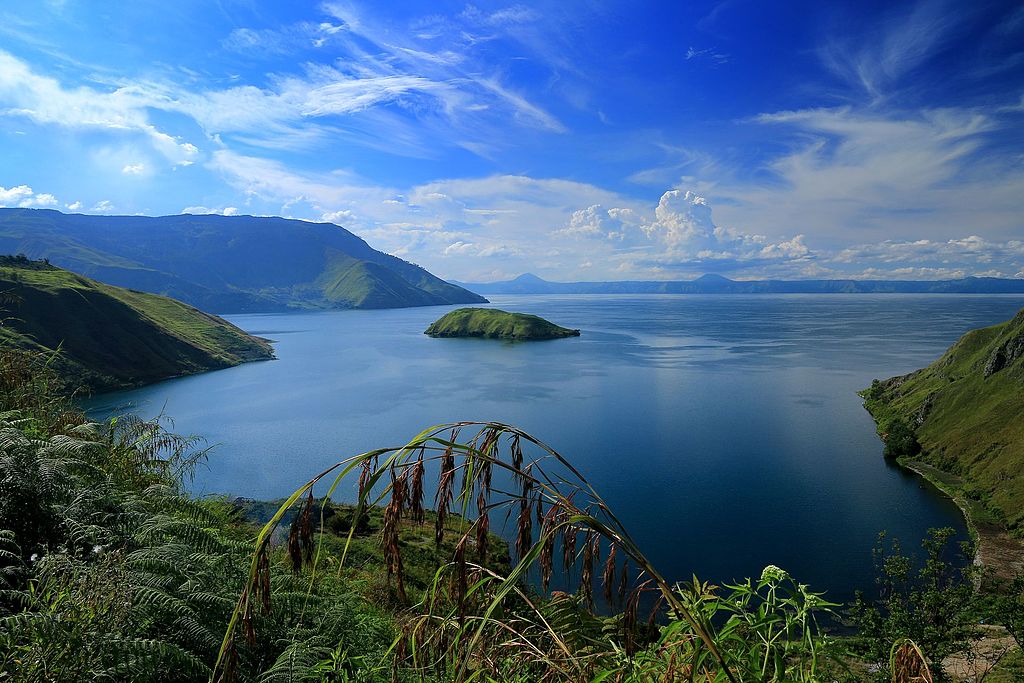
A view Danau Toba from Samosir Island. PL 05 SIGIT, CC BY-SA 4.0, via Wikimedia Commons
How to go from Bali to Lake Toba?
By plane
1. The fastest flight from Bali to Lake Toba (DTB Silangit Airport) lasts 5h 50m hours (3.75h flight + 1h 20m transit)
-
- Ngurah Rai (DPS) >via Jakarta (CGK) 1h 30
- Transit in Jakarta: 2h 30
- Jakarta (CGK) > Silangit (DTB) 2h30
Airlines from Bali to Lake Toba:
2. Ngurah Rai (DPS) > Medan (KNO) 3h 25m (direct flight), then 6 hours drive to Lake Toba.
Airlines from Bali (DPS) to Medan (KNO):
By car or bus
From Bali to Lake Toba it takes around 55 hours drive.
How to get to Lake Toba?
To visit Lake Toba and Samosir Island will require a little effort.
Most travelers used to pass through Medan on their way to Parapat. From the latter, it takes about four to six hours by car to reach Lake Toba.
However, since November 2017, a Silangit Airport (DTB) has been inaugurated and is located east of the lake and it now takes 30 minutes to get to Balige. Daily flights connect the city to Medan and Jakarta. Since June 2018, new destinations have been opened, notably for Penang and Kuala Lumpur.
There is no direct means of transport to get to the island of Samosir, located inside Lake Toba. You will first need to take a plane to Medan, a city in North Sumatra, then take a taxi to Parapat (the nearest town to Lake Toba) and from Parapat, take a boat or ferry to Tuk Tuk on the island of Samosir.
Step 1
Fly to Medan. You can take a look at this article for all the information to book a domestic flight in Indonesia. From Bali to Medan, the flight time lasts an average of 3.5 hours and the price fluctuates between €90 and €200 depending on the season and the company.
Or fly from Bali (DPS) to Silangit Airport (DTB) takes 6 hours (including the stopover in Jakarta)
- Bali (DPS) > Jakarta (CGK): Travel time: 1 hr 50 min
- 2 hours layover Jakarta (CGK)
- Jakarta (CGK) > Silangit Airport (DTB): Travel time: 1 hr 55 min
- Then from Silangit Airport (DTB) to Lake Toba, takes only 30 minutes drive.
Step 2
Take a taxi to Parapat (a small town on the shore of Lake Toba). The journey takes 4 to 6 hours. There are three ways to get to Parapat:
- Shared taxi: IDR 80,000/person. The taxis there are mini-vans that have a maximum capacity of 7 passengers. The vehicle will only leave when it is full. You can book one directly from your hotel in Medan or at the Transportation Desk at the airport.
- Private car: IDR 400,000
- Public bus: IDR 35,000/person. If you take this means the public bus, you obviously will not have the same comfort as in a private car or a mini-van (you will be tight, the seats are very uncomfortable and smoking is allowed in the vehicle)
Step 3
Take the ferry from Parapat to Tutuk on Samosir Island. There is a regular ferry service that operates every hour from 8:30am to 7:00pm. You can buy your tickets in Parapat or directly on the boat for IDR 7,000. The ferry from Tuk Tuk to Parapat also operates every hour from 7am to 5pm.
Flight from Bali to Lake Toba via Medan Airport Kualanamu International Airport (KNO)
Direct flight from Bali Airport (DPS) to Medan takes 2h 30mn. Then you have to drive or take a bus and it takes around 6 hours drive.
Airlines from Bali to Medan:
- Lion Air (nonstop flight available 3h 25m)
- Air Asia (nonstop flight available 3h 25m)
- Batik Air (no direct flight, you need to stopover in Jakarta)
- Citilink (no direct flight, you need to stopover in Bandung or Jakarta)
- Garuda Indonesia (no direct flight, you need to stopover in Jakarta)
- Super Air Jet (no direct flight, you need to stopover in Jakarta)
How to go to from Medan to Parapat
Mostly, travelers come from Medan to go to Lake Toba. If this is your case, to get to Parapat on the shores of the lake facing Samosir, the easiest way is to take a tourist minibus from the Amplus Central bus station. It is a little more expensive than public transport, but it avoids bus changes and saves time. The price is around IDR 80,000 for a 4-5 hours drive.
By local bus there will be changes. Account 40,000RP (2.5 euros) and 5-6h drive (departures every hour).
The shared taxi offer is almost equivalent. It leaves when it is “full” (up to 7 places). Account 90,000 Rp per person (negotiable!), plus IDR 10,000 for the faster toll road.
A normal taxi, just for you: IDR 400,000 by negotiating well (about 25 euros)
How to go to from Parapat to Tuk-Tuk
Transport to Samosir Island (Lake Toba) from Parapat is by ferry. From the pier of Parapat, take the ferry to Tuk Tuk which is opposite on the island of Samosir. boats leave every hour from 8:30 a.m. to 7 p.m.
Parapat has no real interest and we advise you to immediately go to Samosir. Know this says that it is quite possible to sleep in Parapat (in the case for example where you miss the last boat). Once in Tuk-tuk, you will find everything you need in guesthouse and restaurant. If you want to isolate yourself even more, you will still need time to leave Tuk-tuk for your accommodation (bus? or taxi? or boat? several options are possible, check with your guesthouse).
Read also: Bali Airport DPS | Important and Practical Tips to Improve your Experience at Ngurah Rai Airport
Direct flight from Kuala Lumpur Malaysia to Medan only 1 hour
There are direct flights from Kuala Lumpur (KUL airport) to Medan (KNO airport) with only 1hour flight time. Then you have to drive or take a bus and it takes around 6 hours drive.
Airlines from Kuala Lumpur (KUL) to Medan (KNO):
Direct flight from Singapore to Medan only 1h 30mn
There are direct flights from Singapore to Medan with only 1h 30 minutes flight time. Then you have to drive or take a bus and it takes around 6 hours drive.
Airlines from Singapore (SIN) to Medan (KNO):
How to get to Lake Toba? (in short)
There is no direct means of transport to get to the island of Samosir, located inside Lake Toba. You will first need to take a plane to Medan, a city in North Sumatra, then take a taxi to Parapat (the nearest town to Lake Toba) and from Parapat, take a boat or ferry to Tuk Tuk on the island of Samosir.
Transport to Samosir Island (Lake Toba) from Parapat is by ferry. From the pier of Parapat, take the ferry to Tuk Tuk which is opposite on the island of Samosir. boats leave every hour from 8:30 a.m. to 7 p.m.
Culture and people of Lake Toba
Indonesia is the largest Muslim country in the world, but the Batak country remains predominantly Christian Protestant. The Bataks were animists several centuries earlier.
Here is the Batak Toba clan. The island of Samosir is the cradle of this culture. Even today you can witness customs, cultural demonstrations and rituals. Oh ! it is perhaps less impressive than the offerings or sacrifices of the inhabitants of the Toraja country in Sulawesi, Indonesia. But it is always a moving moment to discover such special architecture and traditions. Open your eyes and ears for Batak songs, tribal paintings on the walls and wooden pillar houses with their boat-shaped roofs.
Activities to do and visits around Lake Toba
Discover the many things to see and do around Lake Toba! From ancient temples to traditional villages, there’s so much to explore. Take in the stunning natural beauty and immerse yourself in the rich history of the area.
1. Samosir Island
Day cruise on Lake Toba to discover the white sand beaches and the traditional villages of Ambarita and Simanindo. Then, show of folk dances performed by the villagers. Continue to Tao Island for a swim in the calm waters of the lake. Discovery of the royal tombs of the Sidabutar King family in Tomok.
Samosir island (in the middle). Wagino 20100516, CC BY-SA 3.0, via Wikimedia Commons
Tomok Village
You can do stopover in the village of Tomok for a unique cultural experience. Located at the edge of the Parapat pier, this small village is home to beautiful Batak houses and many historical sites.
The atmosphere in the Tomok, Toba Samosir regency, North Sumatra. Wagino 20100516, CC BY-SA 3.0, via Wikimedia Commons
The atmosphere in the Tomok, Toba Samosir regency, North Sumatra. Wagino 20100516, CC BY-SA 3.0, via Wikimedia Commons
Tomb of King Sidabutar
The tomb of King Sidabutar, the stone statues, the sigale-gale dance performance and the nearby Batak Museum are some of the highlights of the stay. You will also find here many stalls selling typical Batak souvenirs.
Sarcophagus is in a tourist area Tomok, Toba Samosir regency, North Sumatera. Wagino 20100516, CC BY-SA 3.0, via Wikimedia Commons
Binangalom Waterfall
Binangalom Waterfall is one of the most popular attractions on Samosir Island. The waterfall originates from the top of a hill and flows directly into the water of Lake Toba. During the summer season, you can swim in the natural pool of the lake, at the foot of the waterfall. Don’t forget your go-pro to take nice pictures! 🙂
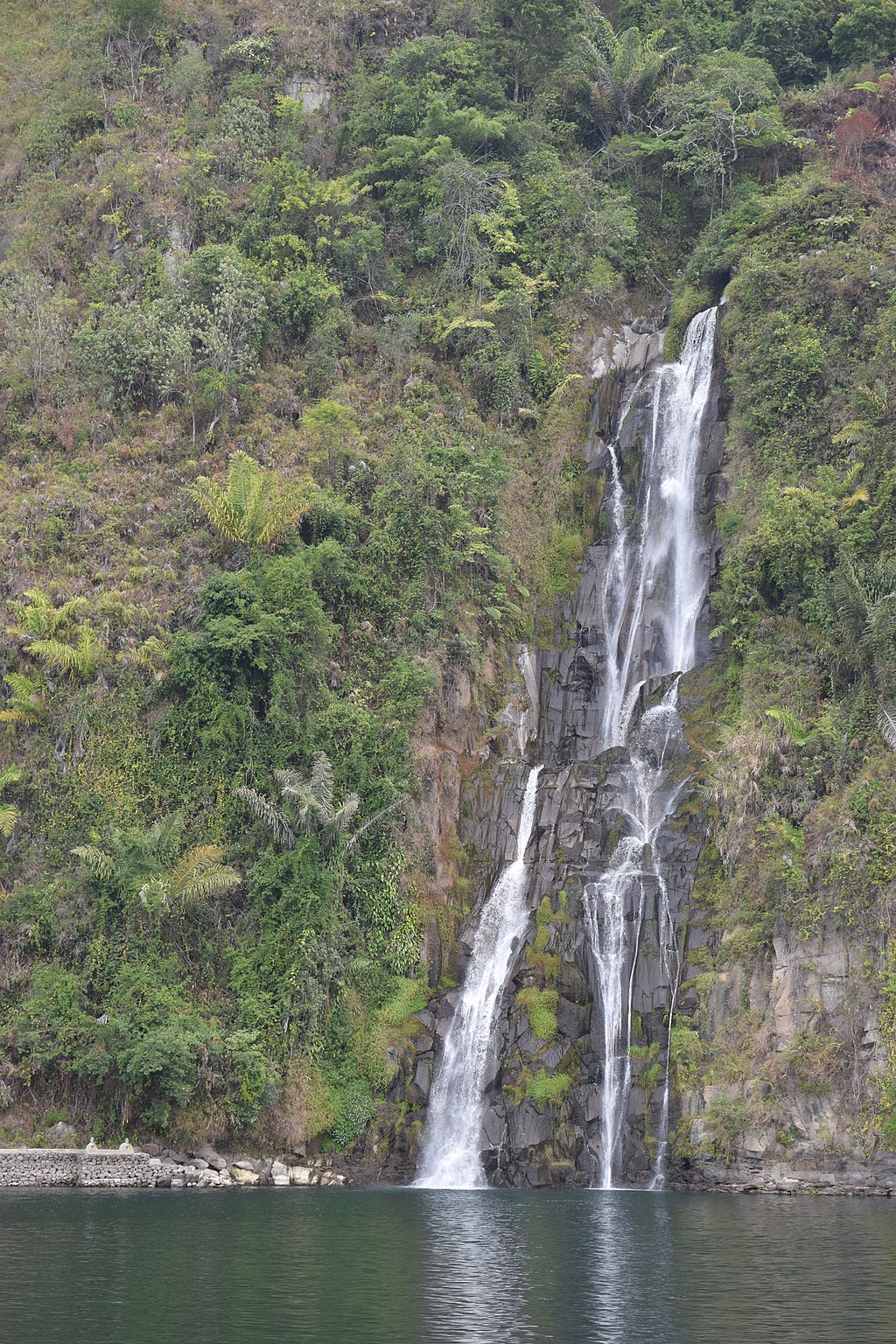
Binangalom waterfall. The other side of Lake Toba, Binangalom Waterfall or commonly called Situmurun by local people. A unique waterfall that directly descends to Lake Toba. Gerry Wowiling, CC BY-SA 4.0, via Wikimedia Commons
Hike Pusuk Buhit Volcano
Pusuk Buhit is a volcano located in North Sumatra. It is inactive and offers a magnificent view of the green hills of the village below. A legend of the Batak people says that the first Batak man (the king) was born on this volcano… Even today, many Batak seniors climb this volcano to obtain divine blessings. Depending on your physical condition, it will take you between 7 and 8 hours of hiking to reach the top of the volcano.

Pusuk Buhit, the small cone has formed on the southwestern margin of the caldera and lava domes. Johnnysiahaan, Public domain, via Wikimedia Commons
Holbung Hill (Bukit Holbung)
Before driving an adventure to the hill it is better to visit the village. There are around 500 people living in Huta Holbung. It may be more than that, though. Due to the beauty of Holbung Hill, more tourists come here. It’s perfect for a trip. Approximately, you can reach the top in 10 – 15 minutes. No problem. There is a path. You can also see a lot of hill weed along the way. Once you reach the top, you will be speechless. The beauty in this hill is incomparable. This can be your next wonderful holiday.
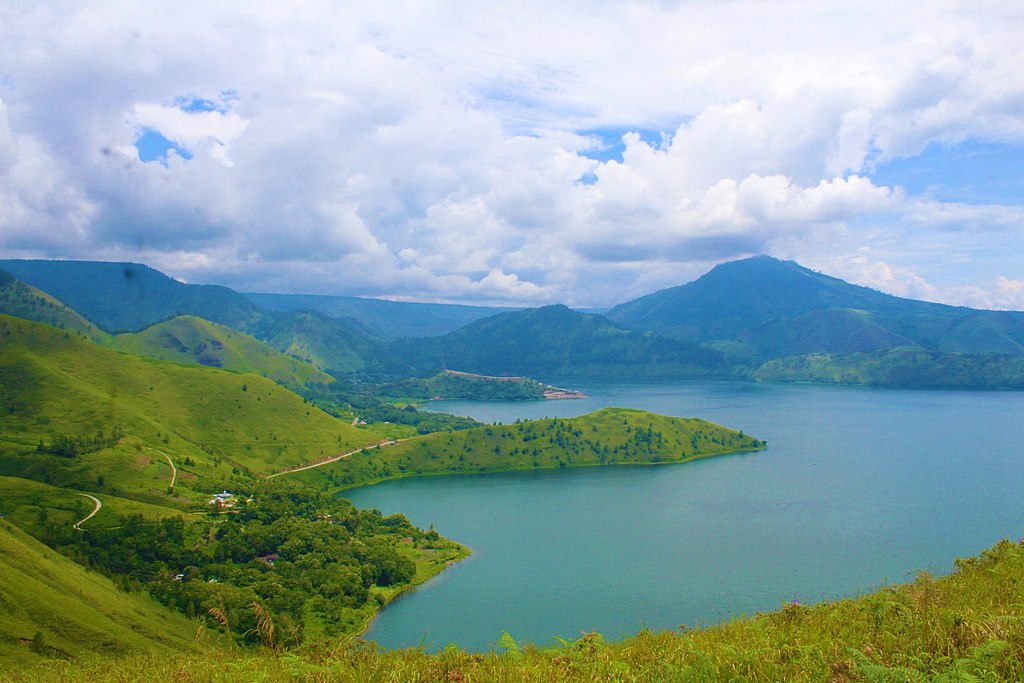
View of Holbung Hill on Samosir island. ButetSinaga, CC BY-SA 4.0, via Wikimedia Commons
The locals even call this location Teletubbies Hill. It is due to its similarity in both beauty and size. Not only does it provide breathtaking scenery, the hill offers refreshing atmosphere. From here you can even see majestic Pusuk Buhit and Lake Toba. All of these attractions make for a great portrait of nature. One thing you shouldn’t clutter up. As a visitor, you must keep the environment clean. Holbung Hill is a valuable tourist attraction in North Sumatra. Everyone should take good care of it.
How to reach the hill: you can use two different routes. First, he is from Medan at Tele. During the trip, you can pass through Kebanjahe. Another route is through Siantar, the Paracoup and Samosir. It depends on your starting point. If you choose the second route, you must use Port of Raja de Tiga to reach Tomok in Samosir Island. What about adaptations? There are several hotels in Samosir. Each of them has distinct facilities and cost. Make sure you bring enough cash.

Bukit Holbung. Francis Hartanto, CC BY-SA 4.0, via Wikimedia Commons
Discover the local culture by visiting the Huta Bolon Simanindo Batak Museum
The museum is simple, but you can see beautiful Batak houses. There are also beautiful pieces of craftsmanship from the region on display in one of the houses. Batak Museum
Entrance fee: IDR 50,000 (including puppet show)
How to get there: The Batak Museum is located in Simanindo, 19km from Tuk Tuk.
Hours: daily from 8 a.m. to 5 p.m.
Telephone: +62 813-9672-1133

Tari Sigale-gale. Life-size puppets of Huta Bolon Simanindo Museum in Simanindo, Samosir Island, North Sumatra, Indonesia. (Puppetry is common in Indonesian culture). Dan Lundberg, CC BY-SA 2.0, via Wikimedia Commons
Bathe in the natural hot springs: Aek Rangat
At the foot of the Pusuk Buhit volcano, very close to Pangururan are the Aek Rangat hot springs. Come and recharge your batteries after your volcano hike!
Aek Rangat Hot Springs
Entrance fee: IDR 2,000 to access the area, swimming pool entrance fee is IDR 10,000
Google Maps coordinates
Hours: daily from 8 a.m. to 5 p.m.
Telephone: +62 813-9672-1133
Hills of Siogung-Ogung hotspring. Christian Advs Sltg, CC BY-SA 3.0, via Wikimedia Commons
2. Parapat
The Sunday market in Pekan Tigaraja
In the village of Pekan Tigaraja, a weekly market is held every Sunday where you can buy Batak handicrafts, traditional clothing and also local and fresh fruits and vegetables. How to get there: The market is located in the small town of Pekan Tigaraja, close to the ferry area.
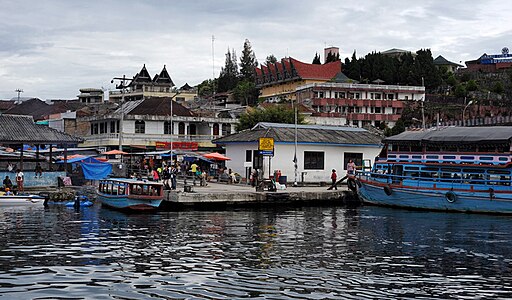
Parapat harbor, Lake Toba, Sumatra. Nomo michael hoefner / http://www.zwo5.de, CC BY-SA 3.0, via Wikimedia Commons
Batu Gantung Rock in Parapat
The town of Parapat takes its name from this historic stone hanging from a rock. According to a local legend, this stone which has the shape of a female silhouette suspended from the wall of a cliff is the symbol of a young woman who found herself trapped in a mountain and who was never rescued. Before being buried alive in the mountain, the young woman would have repeated the word “Parapat”, thus giving this name to the eponymous city. How to get there: The visit of this cliff can be organized with tourist agencies or boat companies

Batu Gantung – Rock Hanging with historical laden story. tigoretagore, CC BY-SA 3.0, via Wikimedia Commons
3. Merek
Take a hike to see the magnificent Sipiso-piso waterfall
Hiking enthusiasts will be delighted to climb this magnificent waterfall which is considered the highest in Indonesia! With a height of 120 meters, this waterfall offers a breathtaking landscape. It is barricaded by lush nature, which makes it an even more natural and extraordinarily beautiful landscape. Admittedly, the hike takes a good 7 hours of walking, but it is really worth it. If you are in good physical condition, I really advise you not to miss this beautiful waterfall.
Read also: From Bali To Raja Ampat (4 Kings) | Complete Guide to Visit West Papua
How to get there: Head by scooter to Simanindo, northeast of Samosir, 20 minutes by Tuk Tuk. Then take a boat to Tigaras. Then you have to take the scooter back to Merek (you will see beautiful landscapes on the road), and ask the locals where the junction is to get to the Sipiso-Piso waterfall (the signs indicate the road only when you come from the North of the island).

Sipiso-Piso Waterfall is located in Tongging Village, Brand District, Karo Regency, North Sumatra Province. NOVA BARUS, CC BY-SA 4.0, via Wikimedia Commons
Medan Region and Bukit Lawang
It is a volcanic island with tropical forests, mountains, volcanoes but also heavenly beaches and beautiful villages to visit in some isolated areas of Sumatra.
Medan region
Medan is a large port city located in the northern part of the island of Sumatra. It is also the capital of the northern province. It is the second most populous city in Indonesia behind Jakarta with over 4.5 million inhabitants.
It is a very charming city that welcomes many tourists who come to travel to Indonesia every year. There are many tourist sites and attractions.
The most famous and visited place is the Masjid Raya Al Mashun mosque. You can also visit the Maimun Palace which is a huge building. There are also beautiful beaches that are often crowded with tourists and locals.
Here are the places to visit in the Medan region of Sumatra:
- The Maimun Palace
- Tjong A Fie Mansion
- Masjid Raya Al Mashun Mosque
- Graha Maria Annai Velangkanni Temple
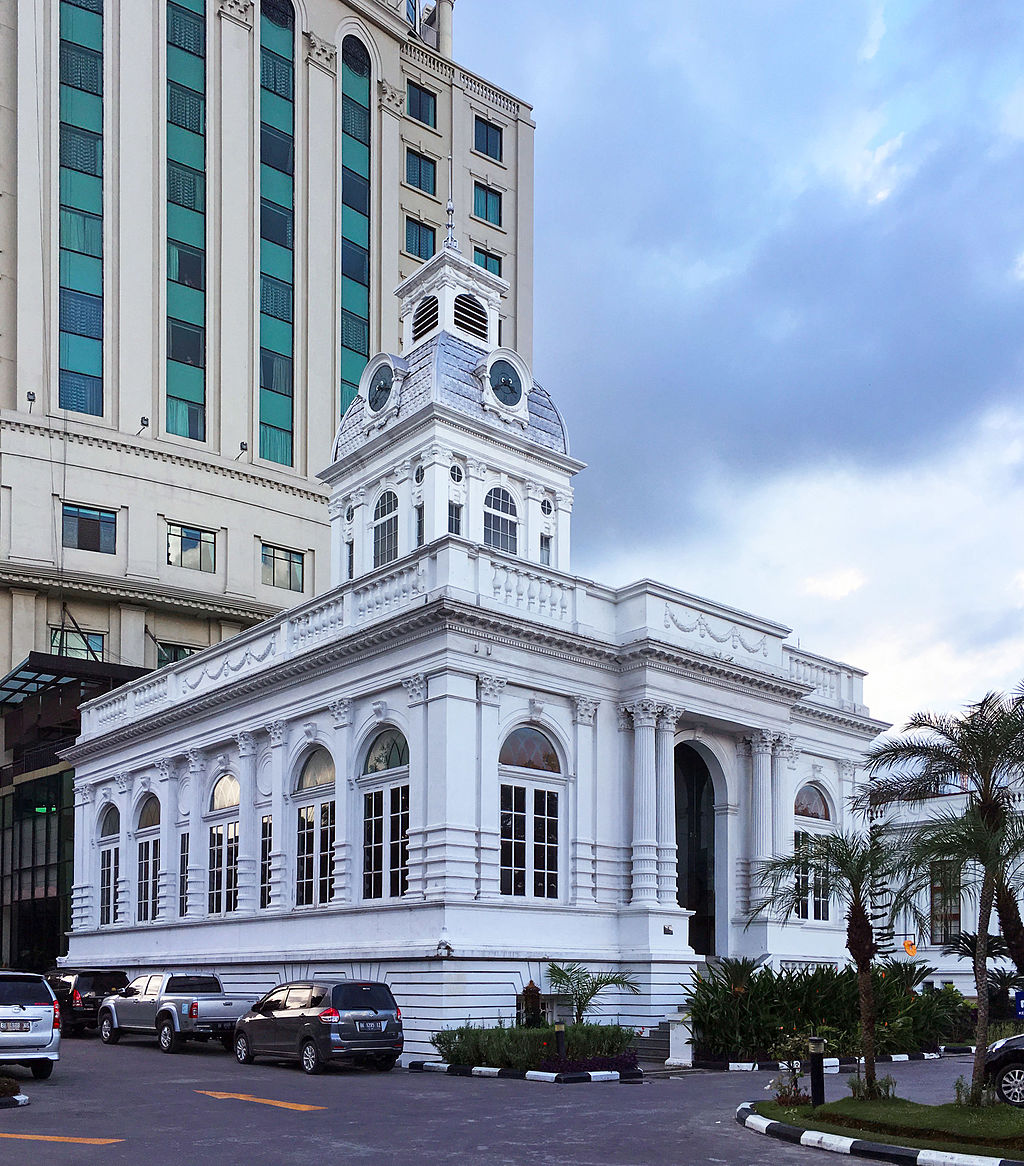
Medan’s Old City Hall. Rochelimit, CC BY-SA 4.0, via Wikimedia Commons
Bukit Lawang
Bukit Lawang is a small tourist and unmissable village located in North Sumatra. Tourists meet there to observe a rare species of monkey: orangutans.
It is also the gateway to Gunung Leuser National Park. Visiting Bukit Lawang will give you the opportunity to observe the last living wild orangutans on the planet.
Here, the forest is heavenly and you can go deep into the jungle by taking many hiking trails. Exploring the jungle will allow you to discover many other incredible species such as the Sumatran tiger or the rhinoceros.
The village is crossed by the Bahorok River on which many water activities can be offered.
Bukit Lawang is definitely one of the must-see places to visit in Sumatra and Indonesia!

Orang-Utan In Bukit Lawang, North Sumatra. Tbachner, Public domain, via Wikimedia Commons
Here are some ideas of places to visit in the Bukit Lawang area:
- The trek in search of orangutans
- Bukit Lawang Wisata Alam
- Bukit Lawang Bat Cave
- Selang Pangeran Beach
- Orangutan in Bukit lawang

Bukit Lawang is one of the interesting tourist areas in Bahorok District, Langkat Regency, North Sumatra Province. Bukit Lawang is part of the Gunung Leuser National Park. Meanwhile, Gunung Leuser National Park and the surrounding area are known as the Leuser Ecosystem Area, which is a UNESCO World Heritage Site. It has swift and rocky rivers, dense tropical forests and various protected wildlife. Andreiromario, CC BY-SA 4.0, via Wikimedia Commons
From Medan to Bukit Lawang
Sumatra Travel Guide: Discover the Top Must-Visit Places and Unforgettable Experiences
Sources: CleverlySmart, PinterPandai, Wonderful Indonesia, Northabroad, TripCanvas
Photo credit (main picture): Yudhapohan (CC BY-SA 4.0) via Wikimedia Commons
Photo description: caldera Toba or better known as Lake Toba was designated as a UNESCO Global Geopark at the 209th Session of the UNESCO Executive Council in Paris, France, Tuesday, July 2, 2020.
Ready to book your villa in the heart of lively Seminyak, Bali?

